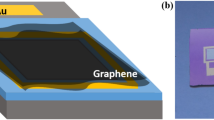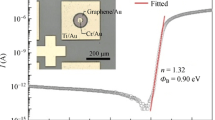Abstract
We explore the electrical properties of graphene–silicon dioxide–p–silicon Schottky junction diode using current–voltage characteristics and impedance analysis. Ideality factor, rectification ratio, and series resistance are extracted from the experimental data. A linear response of series resistance of graphene/SiO2/p-Si Schottky diode is observed with respect to change in forward bias voltage from 0 to 2 V.
Access provided by Autonomous University of Puebla. Download conference paper PDF
Similar content being viewed by others
Keywords
1 Introduction
Graphene, two-dimensional sheet of sp2- hybridized carbon, have extraordinary properties like high transparency (it absorbs only 2.3% of light that passes through it) good thermal and electrical conductivity [1, 2]. The huge scientific and technological interest in graphene has been driven as promising candidates for future semiconductor industries because of its extraordinary properties [2, 3]. Due to high electrical conductivity, it uses as an active layer in electronic device applications and graphene also uses as a metal electrode in electronic devices due to its high transparency and good conductivity which results in the formation of a Schottky contact with various semiconducting materials. The graphene–semiconductor Schottky contact structure has recently been employed in graphene-based devices such as solar cells [4], sensors, lithium-ion battery [5] and LEDs [2, 6]. Therefore, Schottky contact between graphene and semiconductor need to explore briefly. The Schottky device is the simplest and widely used structure, thus, the analysis of Schottky contact between graphene and semiconductor can be considered as an important topic in graphene device application research.
Schottky diodes have various advantages such as low saturation or leakage current and low forward voltage drop. As a result, Schottky diode is extensively used in a variety of RF and microwave applications. In conventional Schottky diode, semiconductor is sandwiched between two metals. One metal makes ohmic contact with semiconductor and other metal makes Schottky contact [7]. Usually, the Schottky diode is a metal–semiconductor device but by inserting insulating layer, between metal and semiconductor, its characteristics and electrical properties are enhanced. MIS Schottky diode offers higher rectification ratio and lower leakage or saturation current [8]. MIS device has nonideal electrical properties therefore frequency-dependent impedance analysis is very important to get accurate and consistent results about fabricated Schottky semiconductor devices.
In this work, we have investigated detailed electrical properties of graphene/SiO2/p-Silicon/Ag Schottky diode with SiO2 oxide layer between graphene and semiconductor using current–voltage characteristics and impedance analysis.
2 Experimental
The p-Si as a substrate or active layer is used in this study. Silicon wafer is oxidized by both dry oxidation (O2) and wet oxidation (H2O) process. The silicon wafers are placed in a furnace under dry oxidation conditions for 10 min. After that, the wafers are exposed to wet oxidation condition for 130 min. Then again dry environment is applied for 10 min. Graphene is synthesized by mechanical exfoliation of highly oriented pyrolytic graphite (HOPG). As HOPG consist of various graphene layers in the stack, they have Van der Waals attraction force between adjacent graphene layers. This attraction force is overcome by peeling the layer by the scotch tape, and then multi-layer graphene is achieved. Synthesized graphene is transferred to the SiO2/p-Si/Ag structure. Silver paste with a thickness of around 1–2 μ painted on the whole backside of the substrate (p-Silicon). The total thickness of silicon dioxide is 700 nm.
The current–voltage characteristics are performed by a KEITHLEY source meter and GPIB data transfer card for current–voltage measurements are used and data are recorded by an interface. Impedance analysis is performed by using L-C-R meter. Impedance spectra are recorded in the frequency range from 101 to 105 Hz with a constant DC, i.e., room temperature voltage 25 mV. A response of virtual resistance and capacitance are observed with respect to change in forward bias voltage from 0 to 2 V.
3 Result and Discussion
3.1 Current–Voltage Characteristics
The dark current–voltage characteristics of the graphene/SiO2/p-Si Schottky diode is shown in Fig. 1, It shows typical rectifying behavior. The I-V characteristics of an MIS Schottky diode can be analyzed by the relationship between the diode current and voltage drop across the junction and it can be described by thermionic emission theory as given by following Eq. (1) [7, 9].
where I0 is the reverse saturation current, n is the ideality factor, K is the Boltzmann constant, q is the elementary charge, and T is the absolute temperature in Kelvin. The reverse saturation current can be expressed by Eq. (2).
where A is the contact area, A* is the Richardson constant i.e. 32 A/cm2 K2 for p-silicon, T is the temperature and \( \varPhi_{b} \) is the zero barrier height. Reverse saturation current is 11.2 × 10−8. A which is calculated from Fig. 1 and now barrier height can be calculated by using Eq. (3), i.e., 0.536 eV.
The ideality factor of the graphene/SiO2/p-Si Schottky diode can be calculated by the following Eq. (4) [8]
The ideality factor is calculated from the slope of Fig. 1 in the forward voltage range from 0.5 to 1.5 V and is found to be 9.3. The obtained ideality factor and reverse saturation current shows that graphene/SiO2/p-Si Schottky diode follows a metal–insulator–semiconductor configuration rather than ideal Schottky barrier diode. At higher forward bias, the I-V characteristics show nonlinearity behavior that indicates a continuum of interface states, in which interface states are at equilibrium with the semiconductor. On the other hand, graphene/SiO2/p-Si Schottky diode shows good rectifying behavior with a relatively low reverse saturation current density. There are several parameters, which root deviations from ideal behavior and those must be taken into account. These parameters can be ideality factor, interface states at Schottky junction, series resistance, etc., and these are main parameters of the diode. These parameters exhibit a downward curvature at higher forward bias in the I-V characteristics of the Schottky diode. In that case, Cheung’s method can be used to obtain the series resistance and ideality factor for the Schottky diode.
Cheung’s functions are expressed by [8]
To obtain series resistance, the plots of dV/dlnI versus I is plotted as shown in Fig. 2 to determine n and Rs values. The slope of this plot gives a series resistance value, i.e., 407.3 Ω and intercept at y-axis is equal to \( n\left( {\frac{kT}{q}} \right) \). The \( \frac{kT}{q} \) is the thermal voltage, here, q is magnitude of electrical charge on the electron equal to 1.602 × 10−19 Coulomb, k is a Boltzmann constant. At room temperature, it is calculated approximately as 25.85 mV. Therefore, the calculated ideality factor from the y-axis intercept is 9.34.
4 Impedance Analysis
Figure 3 shows the Bode plots of the graphene/SiO2/p-Si Schottky diode with a different forward bias voltage. The total impedance is plotted versus the frequency. As shown in the Fig. 3, in the higher frequency range the modulus of the impedance is almost similar for the three forward bias voltage. This can be explained considering that the contribution to the total impedance is mainly due to the resistance of the material and it is not affected by the different conditions [4].
With the bias voltage modulus of total impedance is varying it signifying the bias dependence of capacitance and resistance values. As forward bias increasing the modulus of total impedance decreasing because the width of depletion or space charge region is decreasing which decreases the resistance offered by the Schottky junction device. Bulk resistance (series resistance not included) of the Schottky diode is plotted in Fig. 4 for three individual forward bias voltages. Figure 4 shows that decreasing resistance exhibits a downward curvature with respect to increasing forward bias voltage.
5 Conclusion
The current–voltage characteristics and impedance analysis of graphene/SiO2/p-Si Schottky diode have been investigated. The obtained results recommend that graphene/SiO2/p-Si structure follow a metal–insulator–semiconductor configuration rather than the ideal diode. The insulating oxide layer modifies the electrical parameters of graphene/SiO2/p-Si Schottky diode. The series resistance and ideality factor are found to be 407.3 Ω and 9, respectively.
References
Casero, E., Parra-Alfambra, A.M., Petit-Domínguez, M.D., Pariente, F., Lorenzo, E., Alonso, C.: Differentiation between graphene oxide and reduced graphene by electrochemical impedance spectroscopy (EIS). Electrochem. Commun. 20(1), 63–66 (2012)
Mahala, P., Kumar, A., Nayak, S., Behura, S., Dhanavantri, C., Jani, O.: Graphene, conducting polymer and their composites as transparent and current spreading electrode in GaN solar cells. Superlattices Microstruct. 92 (2016)
Dixit, A., Dixit, D., Chandrodaya, V.V., Kajla, A.: Graphene: a new era of technology 3(3), 4–7 (2013)
Bonanni, A., Pumera, M.: High-resolution impedance spectroscopy for graphene characterization. Electrochem. Commun. 26(1), 52–54 (2013)
Zhang, Y.Q., et al.: Silicon/graphene-sheet hybrid film as anode for lithium ion batteries. Electrochem. Commun. 23(1), 17–20 (2012)
Behura, S.K., Mahala, P., Nayak, S., Yang, Q., Mukhopadhyay, I., Jani, O.: Fabrication of bi-layer graphene and theoretical simulation for its possible application in thin film solar cell. J. Nanosci. Nanotechnol. 14(4) (2014)
Mahala, P., Behura, S.K., Kushwaha, A.S., Ray, A., Jani, O., Dhanavantri, C.: A study on the 2D simulation of Pt/InGaN/GaN/metal Schottky junction solar cell. Semicond. Sci. Technol. 28(5) (2013)
Okutan, M., Yakuphanoglu, F.: Analysis of interface states and series resistance of Ag/SiO2/n-Si MIS Schottky diode using current-voltage and impedance spectroscopy methods. Microelectron. Eng. 85(3), 646–653 (2008)
Yim, C., McEvoy, N., Duesberg, G.S.: Characterization of graphene-silicon Schottky barrier diodes using impedance spectroscopy. Appl. Phys. Lett. 103(19), 1–6 (2013)
Acknowledgements
This work has been supported by DST, SERB-NPDF, No. PDF/2017/002640. We thank Dr. Sumitra Singh from CSIR-CEERI, Pilani for providing HOPG to the synthesis of graphene.
Author information
Authors and Affiliations
Corresponding author
Editor information
Editors and Affiliations
Rights and permissions
Copyright information
© 2019 Springer Nature Singapore Pte Ltd.
About this paper
Cite this paper
Mahala, P., Dixit, A., Gupta, N. (2019). Analysis of Graphene/SiO2/p-Si Schottky Diode by Current–Voltage and Impedance Measurements. In: Rawat, B., Trivedi, A., Manhas, S., Karwal, V. (eds) Advances in Signal Processing and Communication . Lecture Notes in Electrical Engineering, vol 526. Springer, Singapore. https://doi.org/10.1007/978-981-13-2553-3_57
Download citation
DOI: https://doi.org/10.1007/978-981-13-2553-3_57
Published:
Publisher Name: Springer, Singapore
Print ISBN: 978-981-13-2552-6
Online ISBN: 978-981-13-2553-3
eBook Packages: EngineeringEngineering (R0)








